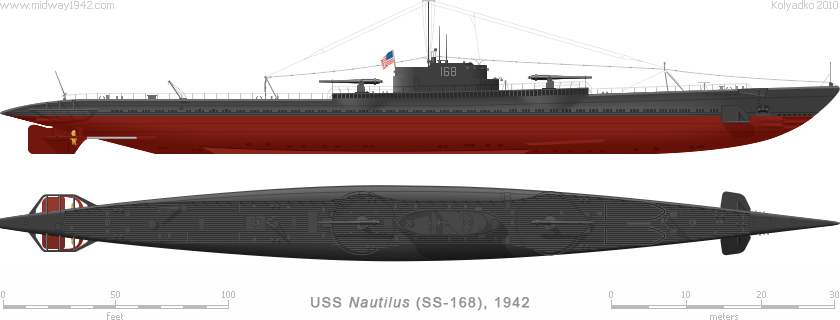
| Narwhal class | SUBMARINES | |

| Displacement: | 2,730 t Surf., 3,900 t Sub. | Machinery: | 4 diesels, 2 electric motors, 2 shafts | Bow Torpedo Tubes: | 6×21 in (533 mm)** | |||||||
|---|---|---|---|---|---|---|---|---|---|---|---|---|
| Max Length: | 371 ft | 113 m | Power Surf./Sub.: | 6,400 / 2,540 hp | 4772 / 1900 kW | Aft Torpedo Tubes: | 4×21 in (533 mm)** | |||||
| Beam: | 33 ft 3 in | 10.14 m | Speed Surf./Sub.: | 14 / 6.5 kts | 26 / 12 km/h | Torpedoes: | 32-36× Mark 14 *** | |||||
| Draft: | 16 ft 11 in | 5.16 m | Range Surf./Sub.: | 9,380 / 50 nm | 17 370 / 92.6 km | DP Guns: | 2×6 in (152 mm)/53 | |||||
| Complement: | 97 officers & enlisted | Test Depth: | 300 ft | 91.5 m | AA MGs: | 1×.30 in (7.62 mm) | ||||||
* Specifications after 1942 refit. ** Including external tubes. *** Including 8-12 torpedoes carried externally.
Submarines SS-167 Narwhal and SS-168 Nautilus have constituted “submarine cruiser” counterparts at least partially inspired by German success with long-range submarine commerce raiders in World War I. Endurance, sea-keeping, increased torpedo capacity, and large deck guns were emphasized at the cost of high speed. Commissioned in 1930, the submarines emerged as too large and unwieldy for fully successful operation: slow to dive, hard to maneuver, and easy to detect. Early in the war, Narwhal and Nautilus were refitted with new diesels and four additional external torpedo tubes, but due to their age and inherent design flaws, they never actually used during the war in the capacity for which they were designed, these submarines were employed primarily to deliver supplies to guerillas, and to transport commandos and coast watchers.
SS-168 Nautilus took part in the Battle of Midway as a part of Task Force 7 Midway Patrol Group (Task Group 7.1) and became the only U.S. submarine engaged the enemy during the battle, although without a success.
| Ship | Builder | Laid Down | Launched | Commisioned | Fate | |||||||||||||
|---|---|---|---|---|---|---|---|---|---|---|---|---|---|---|---|---|---|---|
| SS-167 | Narwhal | U. S. Navy Yard. Portsmouth, ME | 10 | May | 1927 | 17 | Dec | 1929 | 15 | May | 1930 | Sold for scrap | 19 | May | 1945 | |||
| SS-168 | Nautilus | U. S. Navy Yard. Mare Island, CA | 10 | May | 1927 | 15 | Mar | 1930 | 1 | Jul | 1930 | Sold for scrap | 16 | Nov | 1945 | |||